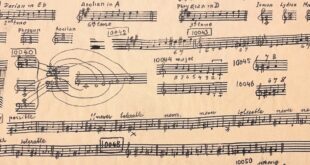Baroque architecture in Vienna concentrates on the inner districts. The opulent period buildings boast squiggly façades, chubby-cheeked cherubs, and delicate stuccos. To make sure they cross your path use my guide below to select the top 10 of five dozen baroque palaces, churches, and landmarks.
Top Three Baroque Architects
Vienna’s baroque architecture was dominated by three architects: Johann Bernhard Fischer von Erlach (Schonbrunn Palace, Augarten Palace, Church St. Charles Borromeo a.o.), Lucas von Hildebrandt (Belvedere Vienna a.o.) and Domenico Martinelli (Liechtenstein Town Palace, Palais Harrach a.o.). The Siege of Vienna by the Turks (1629) and the end of the 30-Year-War (1648) left much of a blank canvas to draw on for them.
Church St. Charles Borromeo
 Baroque architecture in Vienna. Our prime baroque building is based on a promise made good. Habsburg Emperor Charles VI. (the father of Empress Maria Theresia) had it built when the pestilence epidemic finally left Vienna in 1714. In fact, Karlskirche Vienna carries the name of Charles’ patron saint and pestilence saint Charles Borromeo. Viennese baroque star architect Johann Bernhard Fischer von Erlach (1656 to 1723) and his son planned and built the church for 23 years until it was completed in 1737.
Baroque architecture in Vienna. Our prime baroque building is based on a promise made good. Habsburg Emperor Charles VI. (the father of Empress Maria Theresia) had it built when the pestilence epidemic finally left Vienna in 1714. In fact, Karlskirche Vienna carries the name of Charles’ patron saint and pestilence saint Charles Borromeo. Viennese baroque star architect Johann Bernhard Fischer von Erlach (1656 to 1723) and his son planned and built the church for 23 years until it was completed in 1737.
This picture was taken during the annual pop festival in front of the church. The two columns in front of the church were inspired by the Trajan Column in Rome. They are one of many inspirations from Greek and Roman architecture used in- and outside the church. My favourite element are Johann Michael Rottmayr’s baroque picture book frescoes in the church’s vast oval shaped dome: a celestial universe in vivid pastels, featuring illuminated saints, chubby cheeked cherubs, fierce archangels, and Jesus and God in heavenly unison.
![]() My tip: The Church St. Charles Borromeo regularly hosts baroque classical music from Wolfgang Mozart and Antonio Vivaldi. Read more in Vienna Concerts.
My tip: The Church St. Charles Borromeo regularly hosts baroque classical music from Wolfgang Mozart and Antonio Vivaldi. Read more in Vienna Concerts.
Schonbrunn Palace
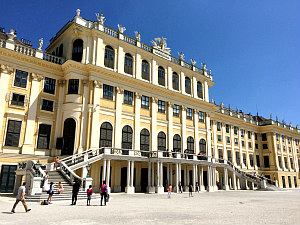 Baroque architecture in Vienna.Schonbrunn Palace, a UNESCO World Heritage site, is Vienna’s epicentre of baroque and rococo art. Johann B. Fischer von Erlach built the palace on commission from Emperor Leopold I in the early 18th century. It replaced the old hunting castle. Schonbrunn has approximately 1,400 rooms in various styles. Most characteristic are its white washed walls with gold leaf stucco decorated ceilings, and bright red upholstered furniture.
Baroque architecture in Vienna.Schonbrunn Palace, a UNESCO World Heritage site, is Vienna’s epicentre of baroque and rococo art. Johann B. Fischer von Erlach built the palace on commission from Emperor Leopold I in the early 18th century. It replaced the old hunting castle. Schonbrunn has approximately 1,400 rooms in various styles. Most characteristic are its white washed walls with gold leaf stucco decorated ceilings, and bright red upholstered furniture.
Empress Maria Theresia of Austria (1717 to 1780) turned Schonbrunn Palace into her summer residence. There, she cultivated a baroque lifestyle of lavish interiors, luxurious wardrobes, exquisite dance balls and horse parades, and musical events performed by the finest baroque composers of her time, such as Wolfang Amadeus Mozart.
Learn more about Schonbrunn Palace and what to see and do there.
Belvedere Vienna
 Baroque architecture in Vienna. The Belvedere Vienna is another renown baroque architecture jewel and UNESCO World Heritage site. The summer residence of Prince Eugene of Savoy consists of two palaces built by baroque architect Johann Lucas von Hildebrandt.
Baroque architecture in Vienna. The Belvedere Vienna is another renown baroque architecture jewel and UNESCO World Heritage site. The summer residence of Prince Eugene of Savoy consists of two palaces built by baroque architect Johann Lucas von Hildebrandt.
The Upper Belvedere (1723) was completed seven years after the Lower Belvedere (1716). To dive into this palace’s baroque world and its art collections join a good small group tour of the Belvedere. Learn all about the Belvedere Vienna.
Imperial Stables (Museumsquartier)
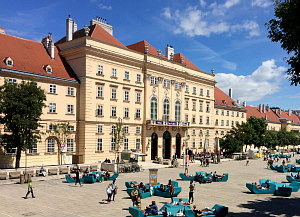 Baroque architecture in Vienna. The Imperial Stables are an unusual piece of baroque architecture in Vienna. Emperor Charles VI (Maria Theresia’s father) commissioned the stables while the Imperial Palace received a baroque makeover. The stables were to accommodate around 600 Imperial horses and 200 carriages. Joseph Emanuel Fischer von Erlach(son of Johann Bernhard, the architect of Schonbrunn Palace), completed them in 1725.
Baroque architecture in Vienna. The Imperial Stables are an unusual piece of baroque architecture in Vienna. Emperor Charles VI (Maria Theresia’s father) commissioned the stables while the Imperial Palace received a baroque makeover. The stables were to accommodate around 600 Imperial horses and 200 carriages. Joseph Emanuel Fischer von Erlach(son of Johann Bernhard, the architect of Schonbrunn Palace), completed them in 1725.
The vast rectangular grid of yellow houses two to four storey high buildings and stretches over 60,000 square metres. The building has a few decorative elements on its façade, such as horse heads and coats of arms, and some baroque sculpture on the roof of what is now called ‘Hall E’. Most spectacular are the large vaults of the horse stables which open up the space, and some exquisitely stuccoed wall niches in the interior.
Today, the Imperial Stables house the Museumsquartier, Vienna’s largest museum’s complex, and the eighth largest cultural complex in the world. It is one of the best showcases of baroque architecture in Vienna integrating 21st century elements. Learn more in Vienna Museums.
Kinsky Palace Vienna
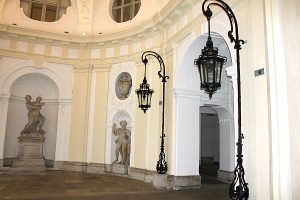 Baroque architecture in Vienna. The Kinsky Palace Vienna, or Palais Daun-Kinsky, is my favourite town palace in Vienna: The building by Johann Lucas von Hildebrandt presses every button of baroque architecture: the iconic pilasters of the façade, arabesques, escutcheons and flutes, a vast selection of baroque sculpture at the grand portal, above windows and on the roof, as well as in the foyer and grand staircase.
Baroque architecture in Vienna. The Kinsky Palace Vienna, or Palais Daun-Kinsky, is my favourite town palace in Vienna: The building by Johann Lucas von Hildebrandt presses every button of baroque architecture: the iconic pilasters of the façade, arabesques, escutcheons and flutes, a vast selection of baroque sculpture at the grand portal, above windows and on the roof, as well as in the foyer and grand staircase.
The interior is rich in domes and vaults, gold plated lanterns and mirror frames, fine white stucco decoration, and colourful frescoes displaying mythological allegories.
The rectangular-shaped palace at Freyung square in the city centre was completed in 1719 on commission of Count Daun. In 1784 it was acquired by Countess Kinsky. The palace stretches far into the back, and is structured in two inner courtyards. The foyer includes a bust of the current owner, Austrian retail tycoon and self-made billionaire Karl Wlaschek, who has also established his own family mausoleum in the palace’s rear.
Today, the Kinsky Palace hosts an art auction house and the chic restaurant and bar ‘Freyung 4’.
Lobkowitz Palace
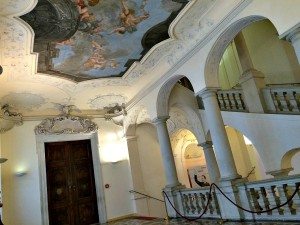 Baroque architecture in Vienna. The Lobkowitz Palace (Palais Lobkowitz; 1687) is Vienna’s most important baroque town palace. Imperial civil servant Philipp Sigmund Count of Dietrichstein proved to be a visionary real estate developer when he bought two houses on the local pig market (now Lobkowitzplatz). He had them demolished and replaced by today’s palace with the help of Italian-Swiss baroque architect Giovanni Pietro Tencala.
Baroque architecture in Vienna. The Lobkowitz Palace (Palais Lobkowitz; 1687) is Vienna’s most important baroque town palace. Imperial civil servant Philipp Sigmund Count of Dietrichstein proved to be a visionary real estate developer when he bought two houses on the local pig market (now Lobkowitzplatz). He had them demolished and replaced by today’s palace with the help of Italian-Swiss baroque architect Giovanni Pietro Tencala.
Later, Schonbrunn Palace architect Johann Bernhard Fischer von Erlach developed the fabulous main portal, roofed with a three dimensional arch. The other outstanding feature on the façade is the gold plated escutcheon. It is guarded by two angels (puttos) above the main window of the first floor. The highlights of the palace interior are the Eroica Hall and its dark walls that let the large fresco covering the ceiling vibrate with colour. Don’t miss the Hercules fountain in the palace foyer.
Between 1745 and 1980 the palace was owned by the Austrian Lobkowitz family. Today, every student of Theatre Sciences in Austria knows the Lobkowitz Palace (Palais Lobkowitz). It houses the local Theatre Museum, part of the Museum of Fine Arts. Besides that, some private waltz dance lessons take place at the palais (inquire before booking).
Liechtenstein Garden Palace
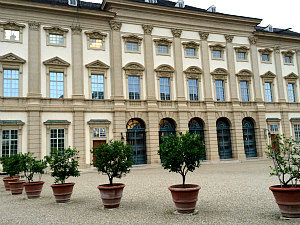 Baroque architecture in Vienna. The Liechtenstein Garden Palace is a free standing baroque gem in Vienna’s ninth district. Prince Johann Adam Andreas I of Liechtenstein commissioned Italian baroque architect Domenico Martinelli at the end of the 17th century to build a palace. He chose the Rossau area of Vienna, close to the Danube canal. The garden palace’s Roman-style unfussy exterior with ionic pilasters and five simple portals opening the way to the grand foyer (Sala Terrena) is almost classic.
Baroque architecture in Vienna. The Liechtenstein Garden Palace is a free standing baroque gem in Vienna’s ninth district. Prince Johann Adam Andreas I of Liechtenstein commissioned Italian baroque architect Domenico Martinelli at the end of the 17th century to build a palace. He chose the Rossau area of Vienna, close to the Danube canal. The garden palace’s Roman-style unfussy exterior with ionic pilasters and five simple portals opening the way to the grand foyer (Sala Terrena) is almost classic.
The most stunning detail of the Sala Terrena are the oval frescoes on the ceilings of the white stucco vaults, the baroque sculptures and the pompous Golden Carriage of the Liechtenstein family. The back of the foyer opens up to the palace garden.
Upstairs, the Hercules Hall mixes red marble pilasters, oil paintings and gold painting stuccoes that are topped by a dazzling fresco of Roman baroque painter Andrea Pozzo. The library features thousands of baroque works. The Badminton cabinet – the most expensive piece of furniture in the world – is another must see of the palace.
Today, the Liechtenstein Palace is one of Europe’s best private art collections. It showcases 500 years of the Liechtensteins’ passion for art. The palace is available for events and group tours (pre-booking required).
Liechtenstein Town Palace
Baroque architecture in Vienna. The Liechtenstein Town Palace was a modern architectural showcase of its time. It was completed almost in sync with the Garden Palace by Italian baroque architect Domenico Martinelli in the early 18th century. Prince Johann Adam I of Liechtenstein had acquired the building when it was semi-finished and extended it through purchasing an adjacent plot.
The grand staircase, with a good dozen angels (putti) playing on the banister, vases, and plant balustrades is one of the most beautiful in Vienna. This was not really Martinelli’s style, however. It was Prince Johann Adam’s vision of on an overboarding baroque design. The palace’s centrepieces are the princely apartments in the first floor, and the Grand Hall on the second floor, which included the prince’s art gallery.
In the 19th century, the English architect Hubert Desvignes refurbished large parts of the palace. Between 2010 and 2013, the Liechtenstein Palace was revitalised and is now available for events and guided pre-booked group tours.
Schottenkirche
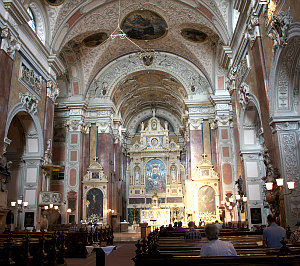 Baroque architecture in Vienna. You may have seen a few baroque churches, though not many in pink. The Schottenkirche, dating back to a Roman church from 1200, has a pink side façade and pink walls framing the white-grey neo baroque stuccos that cover the arches and ceilings like a fine lace. Each of the inner arches and pilasters is decorated with cherubs, which adds to the feminine look and feel of the church. A dozen relief plaster figures hover gracefully beneath the vault hosting the altar.
Baroque architecture in Vienna. You may have seen a few baroque churches, though not many in pink. The Schottenkirche, dating back to a Roman church from 1200, has a pink side façade and pink walls framing the white-grey neo baroque stuccos that cover the arches and ceilings like a fine lace. Each of the inner arches and pilasters is decorated with cherubs, which adds to the feminine look and feel of the church. A dozen relief plaster figures hover gracefully beneath the vault hosting the altar.
The baroque refurbishment of Schottenkirche from 1648 was completed by Italian architects Andrea Allio the Elder and Andrea Allio the Younger. The second baroque renovation took place after the Siege of Vienna by the Turks in 1683.
The Schottenkirche is also the church of the local Benedictine Abbey, called Schottenstift. At times, it hosts classical concerts, such as those by the Wiener Franz Liszt Society.
Old Vienna City Hall
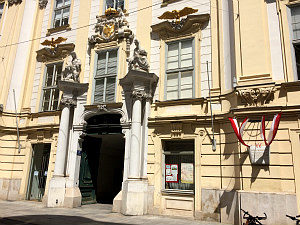 Baroque architecture in Vienna. The Old Vienna City Hall and its sumptuous facade belong to Vienna’s more ornate baroque gems. I list it here even though it was originally a gothic building. The Old City Hall shows how elements of baroque architecture transform the look and feel of buildings from a different epoch.
Baroque architecture in Vienna. The Old Vienna City Hall and its sumptuous facade belong to Vienna’s more ornate baroque gems. I list it here even though it was originally a gothic building. The Old City Hall shows how elements of baroque architecture transform the look and feel of buildings from a different epoch.
The grand portal and façade tell stories of this transformation: Two females dressed in Roman attire and their offspring, placed on ionic columns, gard the main entrance. They are watched by two gold-plated eagles balancing on golden spheres, and by two cherubs holding a golden crown, just above the windows of the first floor.
The baroque decorative elements emulated the style of Schonbrunn Palace and St. Charles Borromeo architect Johann Bernhard Fischer von Erlach.
Today, you can visit the Documentation Archive of the Austrian Resistance at the Old City Hall, which it shares with the Museum for the First District (Bezirksmuseum Innere Stadt) and the Local District Authority.
Other Key Baroque Architecture In Vienna
Böhmische Hofkanzlei, Palais Auersperg, Palais Dietrichstein, Palais Esterhazy, Palais Fürstenberg, Palais Harrach, Palais Lamberg, Palais Schönborn, Palais Schwarzenberg, Pasqualati Haus, Peterskirche, Jesuitenkirche, Rochuskirche, Palais Strozzi, Palais Trautson, Winter palace of Eugen of Savoy;
back to Baroque Period in Vienna
get help planning your program in Vienna
explore more Vienna Tourism Tips
go to Vienna Unwrapped homepage

